On January 24, Archie Comics abandoned the Comics Code Authority, following a similar decision by DC Comics last week. The Comics Code is officially dead, though it had been dying the slow, painful death of irrelevance for some time. But way back when I was a youngster, the CCA was still a significant part of the comics industry, so I thought it would be worthwhile to take a look at the Code.
Most of the readers of this blog are probably familiar with the history of the CCA, but for those of you who aren’t comic historians (in other words, you have a life), I’ll go over the basics. By the early 1950s, there were an increasing number of comics that had nothing to do with superheroes, including rather violent horror and crime comics. Concerned about the unsavory content of these titles, psychiatrist Fredric Wertham published Seduction of the Innocent in 1954, which accused the comics industry of harming young readers and leading them to a life of crime and sexual deviancy. That same year, the Senate Subcommittee on Juvenile Delinquency held public hearings and threatened to establish a federal censorship authority for comics. To preempt the government, the major publishers created the Comics Code Authority, a self-censorship regime loosely based on the Hays Code used by Hollywood studios. While not enforceable by law, most retailers refused to distribute comics that were not approved by the CCA, effectively ending the publication of dozens of titles.
But cultural values changed, and over the last three decades the Comics Code was frequently revised or ignored by the major publishers. Faced with an aging reader base, Marvel and DC continually upped the violence and sex to sustain sales. A new generation of mainstream publishers like Image Comics rejected the CCA outright, instead relying upon in-house content rules. Underground creators and the “artsy” publishers did not censor their works at all (not formally, at least). And then there was manga. By the time Marvel abandoned the CCA in 2001, the CCA seal of approval had become a largely meaningless label.
But in its early years, the Comics Code was a comprehensive and profoundly restrictive instrument. The original draft from 1954 is available on WikiSource. Below, I list what I believe to be the most significant sections. Also included are examples of comics affected by the Code.
Violence and Gore
“Scenes of excessive violence shall be prohibited. Scenes of brutal torture, excessive and unnecessary knife and gunplay, physical agony, gory and gruesome crime shall be eliminated.”
Excessive? Maybe a little
“All scenes of horror, excessive bloodshed, gory or gruesome crimes, depravity, lust, sadism, masochism shall not be permitted.”
Gory? Perhaps for the faint of heart
“All lurid, unsavory, gruesome illustrations shall be eliminated.”
Gruesome? Hell yeah!
“Scenes dealing with, or instruments associated with walking dead, torture, vampires and vampirism, ghouls, cannibalism, and werewolfism are prohibited.” [zombies are bad, call them zuvembies]
“No comic magazine shall use the word horror or terror in its title.”
Putting the word “horror” twice on the cover wasn’t the best idea
Crime and Law Enforcement
“Crimes shall never be presented in such a way as to create sympathy for the criminal, to promote distrust of the forces of law and justice, or to inspire others with a desire to imitate criminals.”
Who could sympathize with a babe in a low cut dress?
“Policemen, judges, Government officials and respected institutions shall never be presented in such a way as to create disrespect for established authority.” [obey!!!]
“The letters of the word “crime” on a comics-magazine cover shall never be appreciably greater in dimension than the other words contained in the title. The word “crime” shall never appear alone on a cover.”
It’s about CRIME
Profanity
“Profanity, obscenity, smut, vulgarity, or words or symbols which have acquired undesirable meanings are forbidden.”
The dialogue was not photo-shopped
“Although slang and colloquialisms are acceptable, excessive use should be discouraged and, wherever possible, good grammar shall be employed.”
Religion and Race
“Ridicule or attack on any religious or racial group is never permissible.” [But Communists? Go to town]
Nudity and Sexuality
“Nudity in any form is prohibited, as is indecent or undue exposure.”
“Suggestive and salacious illustration or suggestive posture is unacceptable.”
Suggestive AND salacious
“Females shall be drawn realistically without exaggeration of any physical qualities.” [Never enforced]
“Illicit sex relations are neither to be hinted at nor portrayed. Violent love scenes as well as sexual abnormalities are unacceptable.”
Zombie lovin’ is abnormal
“The treatment of live-romance stories shall emphasize the value of the home and the sanctity of marriage.”
“Passion or romantic interest shall never be treated in such a way as to stimulate the lower and baser emotions.”
Even bad art can stimulate base emotions
“Sex perversion or any inference to same is strictly forbidden.”
Code for Advertising Material
“Liquor and tobacco advertising is not acceptable.”
“Advertisement of sex or sex instruction books are unacceptable.”
“Advertising for the sale of knives or realistic gun facsimiles is prohibited.”
“Advertising for the sale of fireworks is prohibited.”
[No fireworks?!!! Are we in fuckin’ North Korea?!!]
Drug Abuse
Following an influential storyline in Amazing Spider-Man, The Comics Code was updated in 1971 to allow for the limited depiction of illegal drugs.
“Narcotics or Drug addiction shall not be presented except as a vicious habit. Narcotics or Drug addiction or the illicit traffic in addiction-producing narcotics or drugs shall not be shown or described if the presentation:
Tends in any manner to encourage, stimulate or justify the use of such narcotics or drugs; or …
Stresses, visually, by text or dialogue, their temporary attractive effects; or …
Emphasizes the taking of narcotics or drugs throughout, or in a major part, of the story, and leaves the denouement to the final panels.”
______________
To be up front about my biases, I’m a free speech absolutist, and more importantly, I’m a vulgar degenerate who loves stories with the Three B’s (blood, breasts, and bad words). My natural inclination is to condemn the Comics Code. It stifled free speech, convinced an entire generation of Americans that comics were exclusively “kid’s stuff,” and encouraged conformity and blind obedience to authority. Nor does censorship address the ultimate causes of juvenile delinquency: bad homes, bad neighborhoods, poverty, etc.
On the other hand, I’m not a parent. For someone raising a child, especially in less-than-ideal conditions, the dangers of censorship are probably low on their list of concerns. Looking at the comic covers above, it’s not hard to see why parents and legislators were upset. While there is no definitive evidence showing a causal link between entertainment and criminality, most people believe that comics and other popular media have at least some impact on juvenile attitudes and behavior. That’s hardly a radical notion. And I imagine most parents, even today, would freak out if they discovered their child reading some of those titles. Perhaps someone with children can offer their thoughts.
But even if these comics were dangerous, a ratings system that distinguished between child and adult comics would have been preferable to a blanket censorship regime that effectively killed entire genres. Adults could find books tailored to their tastes while parents received guidance on which titles were age-appropriate for their children. Unfortunately, such ratings did not exist in 1954 (the motion picture industry did not adopt a ratings system until 1968). And by the time ratings became more common in other media, mainstream comics had settled into their comfortable superhero dependency.


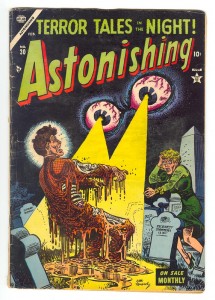
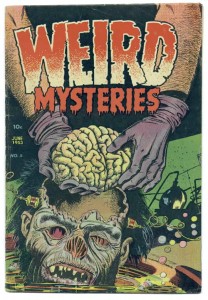
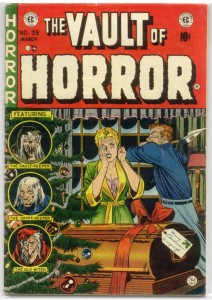

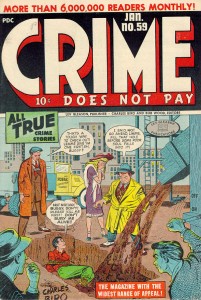
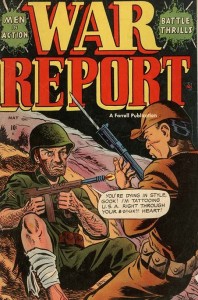
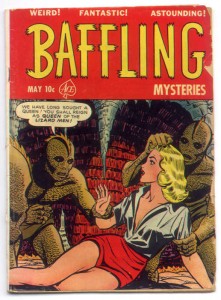
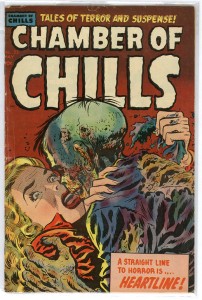
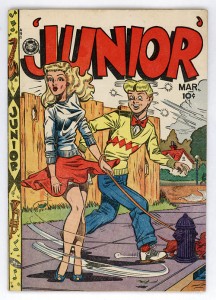
I’m a parent! I think the movie ratings are fairly helpful in terms of giving you an idea of whether or not it’s something that’s going to terrify/confuse/bore your child. (As well as being a nice shorthand to explain to said child why he might be bored/confused/whatever.)
I don’t think I’d ever be worried that reading or seeing inappropriate material would lead my kid to a life of crime and degeneracy. Mostly I’d be worried that he’d be scared and wouldn’t be able to sleep, which would then be a pain in the ass for me (and unpleasant for him.) The moral panic crap is silly and censorship is unnecessary, but vague guidelines for parents are somewhat helpful.
Especially with the idiotic super-heroes, where they use the same stupid characters for five year olds and then turn around and have them raping each other’s eye sockets.
The superheroes doing the raping, I mean. Not the five-year-olds.
Okay, I’ll stop now.
If these ratings were ever just guides, then that wouldn’t be much of a problem. They don’t function that way. The industries censor their material to achieve a desired rating or approval. The film industry instituted the Hays Code as a stopgap measure ostensibly in service of the filmmakers, since different regions were butchering the films being shown. Of course, this resulted in a universal, regulated pre-release butchering. That then seeps into the creative bloodstream. Why not just read summary reviews of the films or comics? That would solve the problem of parents and wouldn’t get the tepid King’s Speech dismissed as R (kids shouldn’t see it because it encourages a dangerous sentimentality towards monarchical power, not because of the word ‘fuck’).
I like the brazenly ideological summaries/warnings over at The Christian Spotlight. For example, the film The Kids Are Alright:
This film is not recommended. There are numerous issues of concern to Bible-believing Christian viewers—along with temptations of the eye and mind. This film is R-rated “for strong sexual content, nudity, language and some teen drug and alcohol use.” This extremely offensive movie attempts to make lesbianism and other abhorrent sexuality seem completely normal and is definitely one to avoid. A detailed description of many of its objectionable parts would not be appropriate for this page. Although most secular critics have given it gushing praise, we have noticed that many audience members have come away calling it very boring and offensive, and many theaters have declined to show it.
It gives the reader a knowledge of the film and the warning itself.
I mean, I’m not a super-enthusiastic proponent of the ratings or anything. But…you know, parents are lazy, like most people. A letter gives you a quick idea of what level it’s aimed at. It’s easy.
Having said which…I don’t even know how often I even look at the letters now that I think of it. Mostly kids movies are marketed to kids, so there’s not much confusion. And if I was concerned about something I’d probably look for the rating and then perhaps check a review as well….
Fascist.
That’s Hays code, not Hayes.
Damnit. Fixed the Hays.
Charles- you’re right that ratings are far from perfect, especially when profitability depends on getting a certain rating. But they’re still preferable to what came before.
I’ve read a lot of the reviews on the Christian Spotlight. Shockingly, he doesn’t like any of the movies I like.
Noah- there’s no eye socket raping! Just plain ole’ rape, and dismemberment, child murder, and blood-vomiting. Honestly, kids have to learn about blood-vomiting from somewhere.
Sure, but I’d rather they learned about blood-vomiting at home from their parents, the way it’s always been.
Noah- you are right about the parents being lazy. When I was little, my mom bought me a big collection of EC horror stories. Had she taken a second to look at the stories, there’s no way she ever would have let me read it. But she didn’t look, so I learned that you could play baseball with the pieces of a dismembered corpse.
There’s definitely something to be said for parental laziness. Obviously you don’t want to go too far with it…but it’s not bad for kid’s to have some space to do (very mildly) stupid things on their own.
Robert – I just wanted to say great job on selecting the covers to go along with this article. That “Chamber of Chills” cover is easily one of my favorites!
Those horror comics had eye-catching covers, no doubt.
And thanks for the kind words, I’ll just pretend you got my name right.
Dammit – sorry Richard! How embarrassing!
Pingback: Tweets that mention R.I.P. Comics Code « The Hooded Utilitarian -- Topsy.com
Aaron- no apologies needed.